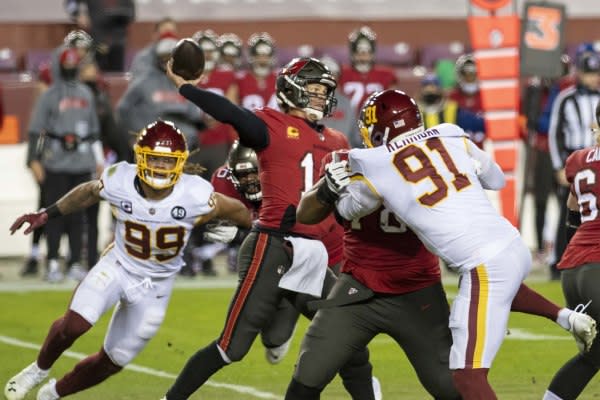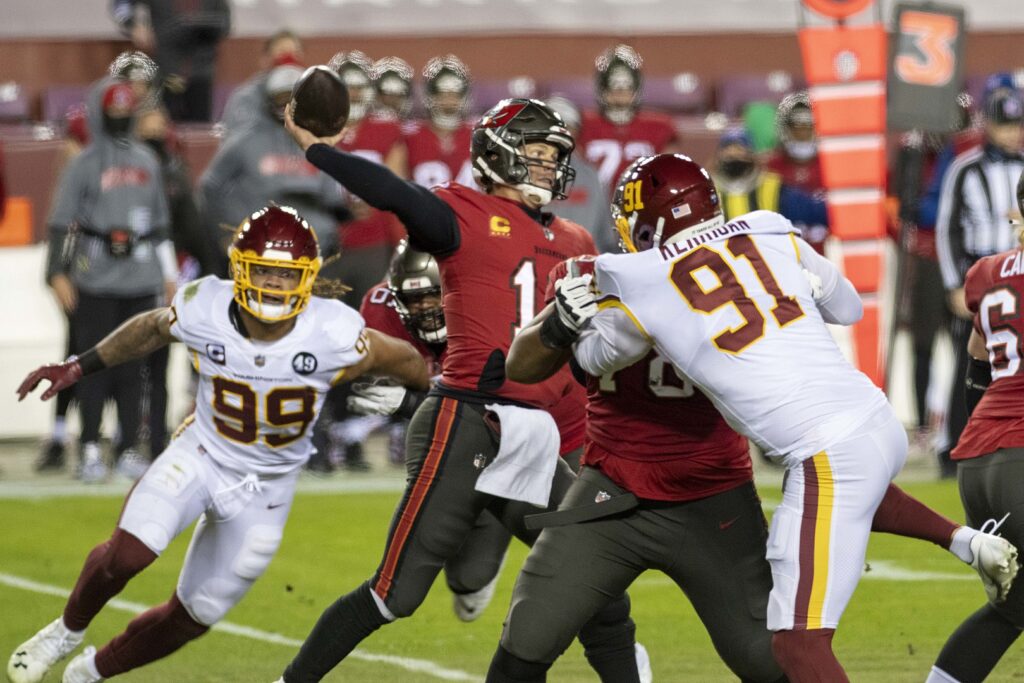
Matthew Coller is an experienced football writer who covered the Vikings for 1500ESPN and Skor North for four years. Also a published author, Coller writes a weekly Vikings column for Bring Me The News, and you can find more of his work at Purple Insider.
If you’re trying hard to find a silver lining to the Minnesota Vikings missing the playoffs, it might be that Vikings fans everywhere had a stress free opening weekend of the postseason. Well, that is unless you were stressing about the things that playoff teams did/do in order to get there and advance and whether the Vikings will follow their path.
So let’s have a look at each team that’s left and what their numbers, roster construction and coaching can tell us about what the Vikings need to do going forward…
Los Angeles Rams
- First round result: Beat Seattle on the road
- Lesson learned: Interior pressure is a big deal
Nobody expects the Vikings to find the next Aaron Donald but never has it been more clear how disruptive a top-notch defensive tackle can be than watching him demolish the Seahawks and chase Russell Wilson all over the field. Because of an injury Donald only rushed the passer 15 times last Saturday and he created six pressures. Vikings starting defensive tackle Jaleel Johnson only had seven pressures all season (per PFF).
To put the difference in interior rush between the Rams and Vikings in context, if you add up the pressures created by all Vikings defensive tackles, you come up with 28. At that rate it would take three seasons to create as many pressures as Donald did this year.
Whether it’s through the draft or in free agency, the Vikings must solve their interior pass rush problem.
Green Bay Packers
- First round result: Bye
- Lesson learned: It’s OK to throw to your best receiver all the time
You’ve probably heard the old football adage “keep doing it until they stop it.” Well, the Packers push that to the extreme with throwing to Davante Adams, who was targeted 149 times in just 14 games this season. The Packers ranked third in the NFL in Expected Points Added, despite their No. 2 receiver getting nearly one-third of Adams’s target total.
The Vikings can spread things out between Justin Jefferson and Adam Thielen more than Green Bay does but they shouldn’t be afraid to lean heavily on Jefferson, especially early in the game. This year Adams had 35 catches in the first quarter while Jefferson had just 16 receptions in the opening quarter (and 28 in the fourth quarter).
By efficiency, Jefferson gained 11.2 yards per target, which was ahead of Adams’s 9.2 yards per target. That displays how effective the Vikings were throwing to their rookie and it might also tell us that throwing underneath more often to Jefferson could be a good thing.
Additional lesson that probably won’t be relevant but you never know: Drafting a future QB in the first round doesn’t ruin the following season.
Baltimore Ravens
- First round result: Defeated Tennessee
- Lesson learned: Veteran free agent defensive linemen can be found
Because the Ravens have a quarterback on a rookie contract, they were able to load up on defensive linemen this year, acquiring Calias Campbell and Yannick Ngakoue in trades and Pernell McPhee and Derek Wolfe via free agency. Against the Titans, Campbell was the highest graded Ravens defender, McPhee was third and Wolfe had three pressures including a sack.
With a tight salary cap situation a player like Campbell would have been out of the Vikings’ range but the total price tag for McPhee and Wolfe was under $4 million. Instead of signing solid veterans last year, the Vikings acquired one expensive player (Ngkaoue) and left their development players to handle the rest. It resulted in the sixth fewest sacks in the NFL. The next time around, the Vikings might want to check the bargain bin on the D-line.
Buffalo Bills
- First round result: Beat Indianapolis
- Lesson learned: Explosive passing game overcomes defensive, running shortcomings
Buffalo leaned into their passing game after acquiring Stefon Diggs and ranked No. 1 in the NFL in Expected Points Added through the air. Buffalo ranked third in passing yards per game and fourth in yards per pass attempt. Their passing game covered for other weaknesses, like ranking 20th in rushing EPA and 16th in points allowed on defense. Against the Colts they only ran for 42 yards with running backs and gave up 472 yards on defense and still came away with a win. The Vikings often leaned heavy on their run game and weren’t able to overcome poor defensive performances.
Cleveland Browns
- First round result: Beat Pittsburgh on the road
- Lesson learned: Pass blocking is important in the playoffs
The Browns ranked No. 1 by Pro Football Focus in pass blocking grade. Against an excellent Steelers defensive line, they allowed Baker Mayfield to be pressured just five times on 36 dropbacks. He threw for 225 of his 263 yards and all three touchdowns with no heat from the Pittsburgh defense.
The Vikings, in comparison, rated 29th by PFF in pass blocking. When Kirk Cousins did have a clean pocket, he had the second best QB rating in the NFL (only behind Aaron Rodgers).
Cleveland’s top graded lineman was Jack Conklin, who they signed this offseason to a three-year, $42 million deal, by the way.
Kansas City Chiefs
- First round result: Bye
- Lesson learned: You can never have too many playmakers
Certainly Patrick Mahomes makes everyone around him better but the Chiefs have stacked explosive players around him. Beyond their two star receiving options Travis Kelce and Tyreek Hill, three other receivers picked up at least 400 yards and just for kicks KC added Le’Veon Bell. The Vikings’ No. 3 receiver Chad Beebe had 201 yards this season.
Tampa Bay Bucs
- First round result: Beat Washington
- Lesson learned: Aggressiveness pays off against good defenses
Washington entered as the fourth best defense in the NFL in points allowed and Tom Brady was still able to push the ball downfield. He completed 13 passes over 10 yards through the air. The Bucs overcame the terrific Washington defensive line by getting deep passes out quickly as Brady averaged just 2.57 seconds from snap to throw, the fifth fastest time of 14 QBs who played last weekend. The Vikings have routinely had some of the slowest snap-to-release times and fallen victim to good defensive lines.
New Orleans Saints
- First round result: Beat Chicago
- Lesson learned: Having a competent backup QB can save a season
Drew Brees has been hurt the last two years and each time the Saints had a backup quarterback who came in and kept them on track to host a playoff game. Teddy Bridgewater went 5-0 in 2019 and Taysom Hill went 3-1 this year. The Vikings have gone with the cheapest option for backup QB the last three years with Kirk Cousins starting. While he may have a great record of durability, it might make sense to develop someone who could keep a season alive in the worst case scenario.









